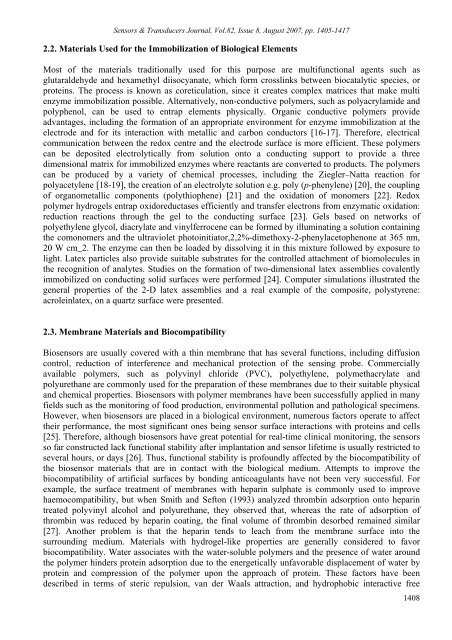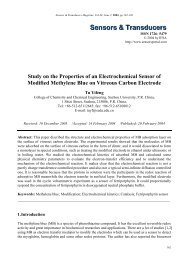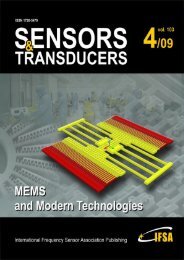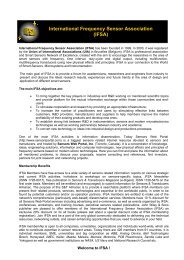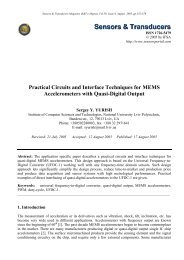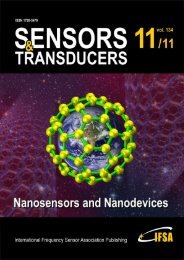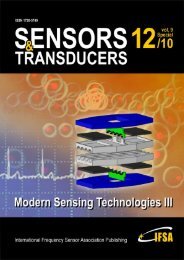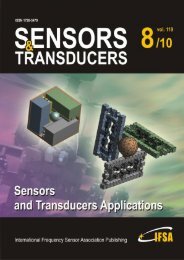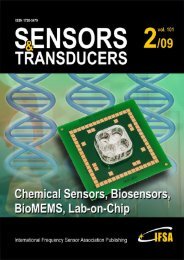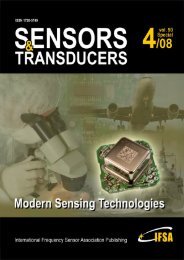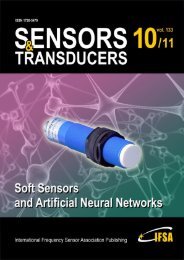Bio-Techniques in Electrochemical Transducers: an Overview
Bio-Techniques in Electrochemical Transducers: an Overview
Bio-Techniques in Electrochemical Transducers: an Overview
You also want an ePaper? Increase the reach of your titles
YUMPU automatically turns print PDFs into web optimized ePapers that Google loves.
Sensors & <strong>Tr<strong>an</strong>sducers</strong> Journal, Vol.82, Issue 8, August 2007, pp. 1405-1417<br />
2.2. Materials Used for the Immobilization of <strong>Bio</strong>logical Elements<br />
Most of the materials traditionally used for this purpose are multifunctional agents such as<br />
glutaraldehyde <strong>an</strong>d hexamethyl diisocy<strong>an</strong>ate, which form crossl<strong>in</strong>ks between biocatalytic species, or<br />
prote<strong>in</strong>s. The process is known as coreticulation, s<strong>in</strong>ce it creates complex matrices that make multi<br />
enzyme immobilization possible. Alternatively, non-conductive polymers, such as polyacrylamide <strong>an</strong>d<br />
polyphenol, c<strong>an</strong> be used to entrap elements physically. Org<strong>an</strong>ic conductive polymers provide<br />
adv<strong>an</strong>tages, <strong>in</strong>clud<strong>in</strong>g the formation of <strong>an</strong> appropriate environment for enzyme immobilization at the<br />
electrode <strong>an</strong>d for its <strong>in</strong>teraction with metallic <strong>an</strong>d carbon conductors [16-17]. Therefore, electrical<br />
communication between the redox centre <strong>an</strong>d the electrode surface is more efficient. These polymers<br />
c<strong>an</strong> be deposited electrolytically from solution onto a conduct<strong>in</strong>g support to provide a three<br />
dimensional matrix for immobilized enzymes where react<strong>an</strong>ts are converted to products. The polymers<br />
c<strong>an</strong> be produced by a variety of chemical processes, <strong>in</strong>clud<strong>in</strong>g the Ziegler–Natta reaction for<br />
polyacetylene [18-19], the creation of <strong>an</strong> electrolyte solution e.g. poly (p-phenylene) [20], the coupl<strong>in</strong>g<br />
of org<strong>an</strong>ometallic components (polythiophene) [21] <strong>an</strong>d the oxidation of monomers [22]. Redox<br />
polymer hydrogels entrap oxidoreductases efficiently <strong>an</strong>d tr<strong>an</strong>sfer electrons from enzymatic oxidation:<br />
reduction reactions through the gel to the conduct<strong>in</strong>g surface [23]. Gels based on networks of<br />
polyethylene glycol, diacrylate <strong>an</strong>d v<strong>in</strong>ylferrocene c<strong>an</strong> be formed by illum<strong>in</strong>at<strong>in</strong>g a solution conta<strong>in</strong><strong>in</strong>g<br />
the comonomers <strong>an</strong>d the ultraviolet photo<strong>in</strong>itiator,2,2%-dimethoxy-2-phenylacetophenone at 365 nm,<br />
20 W cm_2. The enzyme c<strong>an</strong> then be loaded by dissolv<strong>in</strong>g it <strong>in</strong> this mixture followed by exposure to<br />
light. Latex particles also provide suitable substrates for the controlled attachment of biomolecules <strong>in</strong><br />
the recognition of <strong>an</strong>alytes. Studies on the formation of two-dimensional latex assemblies covalently<br />
immobilized on conduct<strong>in</strong>g solid surfaces were performed [24]. Computer simulations illustrated the<br />
general properties of the 2-D latex assemblies <strong>an</strong>d a real example of the composite, polystyrene:<br />
acrole<strong>in</strong>latex, on a quartz surface were presented.<br />
2.3. Membr<strong>an</strong>e Materials <strong>an</strong>d <strong>Bio</strong>compatibility<br />
<strong>Bio</strong>sensors are usually covered with a th<strong>in</strong> membr<strong>an</strong>e that has several functions, <strong>in</strong>clud<strong>in</strong>g diffusion<br />
control, reduction of <strong>in</strong>terference <strong>an</strong>d mech<strong>an</strong>ical protection of the sens<strong>in</strong>g probe. Commercially<br />
available polymers, such as polyv<strong>in</strong>yl chloride (PVC), polyethylene, polymethacrylate <strong>an</strong>d<br />
polyureth<strong>an</strong>e are commonly used for the preparation of these membr<strong>an</strong>es due to their suitable physical<br />
<strong>an</strong>d chemical properties. <strong>Bio</strong>sensors with polymer membr<strong>an</strong>es have been successfully applied <strong>in</strong> m<strong>an</strong>y<br />
fields such as the monitor<strong>in</strong>g of food production, environmental pollution <strong>an</strong>d pathological specimens.<br />
However, when biosensors are placed <strong>in</strong> a biological environment, numerous factors operate to affect<br />
their perform<strong>an</strong>ce, the most signific<strong>an</strong>t ones be<strong>in</strong>g sensor surface <strong>in</strong>teractions with prote<strong>in</strong>s <strong>an</strong>d cells<br />
[25]. Therefore, although biosensors have great potential for real-time cl<strong>in</strong>ical monitor<strong>in</strong>g, the sensors<br />
so far constructed lack functional stability after impl<strong>an</strong>tation <strong>an</strong>d sensor lifetime is usually restricted to<br />
several hours, or days [26]. Thus, functional stability is profoundly affected by the biocompatibility of<br />
the biosensor materials that are <strong>in</strong> contact with the biological medium. Attempts to improve the<br />
biocompatibility of artificial surfaces by bond<strong>in</strong>g <strong>an</strong>ticoagul<strong>an</strong>ts have not been very successful. For<br />
example, the surface treatment of membr<strong>an</strong>es with hepar<strong>in</strong> sulphate is commonly used to improve<br />
haemocompatibility, but when Smith <strong>an</strong>d Sefton (1993) <strong>an</strong>alyzed thromb<strong>in</strong> adsorption onto hepar<strong>in</strong><br />
treated polyv<strong>in</strong>yl alcohol <strong>an</strong>d polyureth<strong>an</strong>e, they observed that, whereas the rate of adsorption of<br />
thromb<strong>in</strong> was reduced by hepar<strong>in</strong> coat<strong>in</strong>g, the f<strong>in</strong>al volume of thromb<strong>in</strong> desorbed rema<strong>in</strong>ed similar<br />
[27]. Another problem is that the hepar<strong>in</strong> tends to leach from the membr<strong>an</strong>e surface <strong>in</strong>to the<br />
surround<strong>in</strong>g medium. Materials with hydrogel-like properties are generally considered to favor<br />
biocompatibility. Water associates with the water-soluble polymers <strong>an</strong>d the presence of water around<br />
the polymer h<strong>in</strong>ders prote<strong>in</strong> adsorption due to the energetically unfavorable displacement of water by<br />
prote<strong>in</strong> <strong>an</strong>d compression of the polymer upon the approach of prote<strong>in</strong>. These factors have been<br />
described <strong>in</strong> terms of steric repulsion, v<strong>an</strong> der Waals attraction, <strong>an</strong>d hydrophobic <strong>in</strong>teractive free<br />
1408


